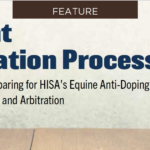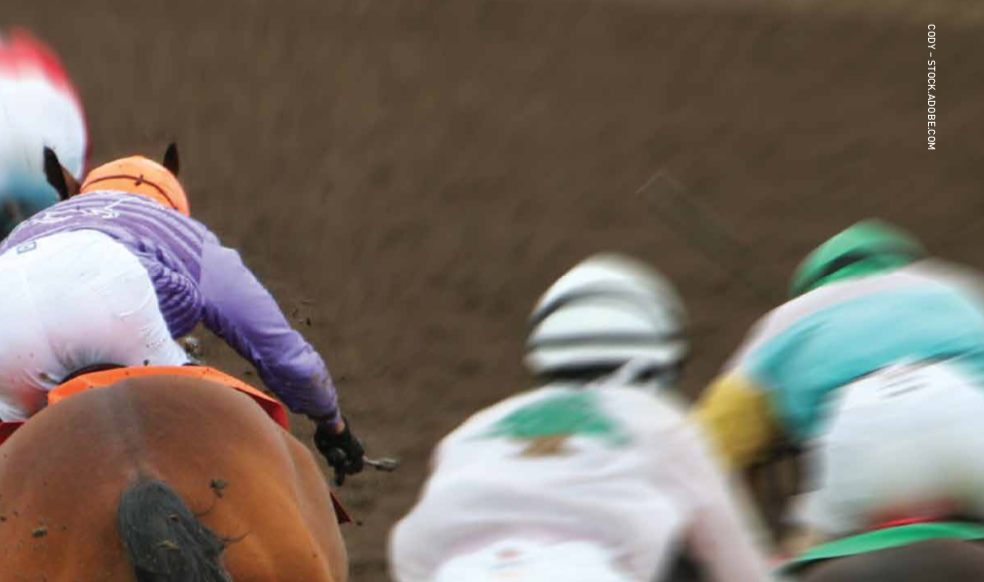Written by Clara K. Fenger, DVM, PhD, DACVIM; Kimberly Brewer, DVM, MSc; Peter J. Sacopulos, JD; Jacob Machin, MS; and Thomas Tobin, PhD, MRCVS, DABT
First published in North American Trainer issue 56 – Summer 2020
In late May, news broke that two of Bob Baffert’s trainees, Charlatan and Gamine, who won races at Oaklawn on May 2, had unconfirmed post-race identifications (positive tests) for lidocaine on that day. Social media and the backstretches of many racetracks have been abuzz with speculation about the dual violations, ranging from “innocent until proven guilty” to “the horses were drugged.” The results of the split sample testing, released just before press time for this issue, confirmed the presence of lidocaine, so it is worth a review of this therapeutic medication and where positives may come from.
Lidocaine identifications in post-race samples occur at a consistent rate of six to eight a year across the country, according to the Association of Racing Commissioners International (ARCI) database. When the lidocaine metabolite in the blood is identified, the levels are typically very low. Are these levels consistent with intentional administration close to race day or consistent with innocent environmental transfer of inconsequential amounts of lidocaine? The answer is in the science.
Lidocaine: What Is It?
Lidocaine is primarily used as a local anesthetic and is most commonly injected into the skin or close to nerves for the purpose of numbing the structure. Lidocaine is similarly used in people, often in dental procedures to block tooth pain. In veterinary medicine, lidocaine is used to numb the skin in the event of a cut or laceration to suture the wound.
Lidocaine also may be used as a regional anesthesia for lameness detection. Because horses are unable to explain why they have an uneven gait or lameness, veterinarians must deduce the source. For example, if a horse is lame as the result of a hoof abscess, the hoof is anesthetized with lidocaine or a similar local anesthetic injected over the nerve supply to the hoof. If the lameness is eliminated after such a “hoof block,” the lameness has successfully been localized to the hoof region.
The final and less common application of lidocaine is for systemic pain control. Horses do not tolerate narcotic pain medications well, so in some cases, such as protracted abdominal pain (colic), lidocaine may be administered as a continuous infusion. This is usually done in a hospital setting because of the requirements for continuous infusion, such as through the use of an intravenous bag.
Lidocaine as a Banned Substance Lidocaine is not a banned substance in racehorses, per se. It is recognized as a therapeutic substance, evidenced by its place on the Controlled Therapeutic Medication Schedule (CTMS), promulgated by the ARCI, as a part of the Uniform Medication Model Rules. In fact, it is expected that a veterinarian would use lidocaine in the normal course of a racetrack practice.
Because of this expectation, the CTMS includes a threshold for the primary metabolite of lidocaine, with a Class 2B penalty, absent mitigating circumstances (see sidebar, ARCI Uniform Classification Guidelines for Foreign Substances and Recommended Penalties Model Rule). Class 2 violations are for the substances second-most likely to affect the outcome of a race. This is a curious classification for lidocaine, because it cannot actually enhance the racing performance of a normal horse.
Why Regulate a Non-Performance-Enhancing Medication at All?
Lidocaine’s use in veterinary medicine is unquestioned, and its ability to enhance performance in a sound horse is universally accepted as nil. However, performance enhancement is not the only reason that medications are regulated in sports that feature animals. Equally important is the regulation of substances that may adversely affect their health and welfare. There is no question that using a local anesthetic intentionally to block the pain of an injury in a horse, and thereby allowing it to race, is inappropriate. Therefore, the existing ARCI regulation that places a 2B penalty on the intentional use of such a substance, absent mitigating circumstances, is appropriate. However, if the science fails to support the published threshold, and the regulator is unable to substantiate how the threshold was developed, how can such severe penalties be imposed on trainers and owners? Further, could there be lidocaine detected in the blood or urine of a horse when no intentional administration has taken place? Of course, there can.
How Lidocaine Is Regulated
The logical regulation of therapeutic medications should allow for their therapeutic use, preclude performance-enhancing or pain-blocking effects at the time of the race and simultaneously prevent inappropriate positive tests as a result of innocent environmental transfer of small amounts of the substance. Unfortunately, as with other therapeutic medications, this logical and commonsense regulation of lidocaine did not occur when the thresholds were set by the Racing Medication and Testing Consortium (RMTC). When the lidocaine threshold was set, the focus was on how to prevent the use of it within 72 hours, and neither the lack of pharmacological effect at 72 hours nor the possibility of inadvertent environmental transfer was considered.
The medication rule for lidocaine presented by the ARCI is shown in figure 1. It states that the threshold is “20 picograms per milliliter of total 3-0H lidocaine in plasma or serum,” with a withdrawal guideline of 72 hours. The supporting information is from European Horseracing Scientific Liaison Committee data; Iowa State University study. The National HBPA and North American Association of Racetrack Veterinarians, as well as scientists and regulated horsemen, have long been critical of therapeutic medication
thresholds based on science that cannot be reviewed.
Why 3-Hydroxylidocaine?
When medications are administered to horses, or any other animals, they are modified and ultimately eliminated by the animal’s body. Typically, the liver facilitates the elimination of substances in the urine, although the animal’s body may use other means of disposal, depending on the substance.
To exert its anesthetic effect, which lasts just under two hours, lidocaine is injected around nerves. Its blood concentration peaks rapidly at about 20 minutes and then drops off. The rate at which lidocaine is eliminated from the blood depends on how it is metabolized. It is rapidly converted into related molecules, called metabolites, the most abundant of which is 3-hydroxylidocaine glucuronide.
The regulation of lidocaine is somewhat unique in horse racing, in that the inactive glucuronide form of the molecule is the regulated analyte in blood. The reasons for this are unclear because the research data from which this threshold was derived have never been published or presented. However, because the 3-hydroxylidocaine glucuronide remains in the blood for a prolonged period after lidocaine administration, it appears to be the only means to identify lidocaine 72 hours after its use.
The animal’s liver works very hard to render medications inactive and ready for elimination from the body. One of the mechanisms the liver employs to accomplish this is to add a glucuronide to the molecule. This addition, such as in the case of lidocaine, renders the molecule inactive and considerably more soluble in water, making it readily eliminated at relatively high concentrations in the urine. As a consequence of this metabolic pathway, many substances that are glucuronidated are regulated by their level in urine and not in blood. The regulation of lidocaine by 3-hydroxylidocaine in blood requires a step in the testing process that is typically reserved for urine testing, and that is the process of hydrolysis, or removal of the glucuronide from the molecule before testing.
Where Does the Current Science Stand on 3-Hydroxylidocaine?
Recent research from Dr. Lawrence Soma at the University of Pennsylvania provides insight into the pharmacokinetics of lidocaine administered to horses. It confirms that 3-hydroxylidocaine, as its inactive glucuronide form, is found in the blood of treated horses. However, this research also shows that lidocaine itself is found at higher concentrations in blood at all times, points during which there is a pharmacological effect and beyond. Since the relevant effect on the animal results from lidocaine and not its inactive 3-hydroxy metabolite, there is no good relationship between the threshold and the effect of lidocaine on the horse. It is a snapshot of a medication administration or exposure in the past with no relevance to its effect on the horse at the time of the race. The ARCI withdrawal time guideline appears to be taken solely from the European Horseracing Scientific Liaison Committee’s 72-hour detection time (figure 2), with no actual relationship to the dose recommendation suggested in the CMTS. Detection times as employed by the EHSLC differ greatly from recommended withdrawal times, because they are based simply on the longest time of detection among usually six or so horses, as shown in figure 2. A substantially longer time period must be used for a withdrawal time to account for individual variation between horses. In clinical practice, almost no racetrack






